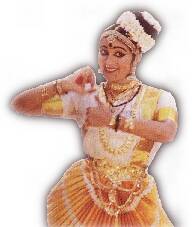
Thullal was introduced in the 18th century by the famous Malayalam poet Kunchan Nambiar (1705 – 1770). A satirist, he is the man who brought literary wit and humour within the ken of common man. His innovative satiric art form Ottanthullal reflected his deep sense of social responsibility. Witticism and anecdotes from the life of this genius have become part of the lores and legends of the State.
There is an interesting story about the origin of the Thullal. Nambiar, who used to play the Mizhavu, (a percussion instrument) during Koothu performances, was once caught napping during a performance and the annoyed Koothu player sent him off the stage. To get his own back, the insulted young man created the new art form overnight and presented it himself the next evening. The audience were thrilled. However this story has been debated by scholar ever since, who believe that it is impractical to create a new art form Thullal overnight.
The Costume: The make up, though simple, is very much akin to that of Kathakali. The actor wears a long tape of white and red coloured clothes looped around the waist-string to form a knee-long skirt. The chest-piece is adorned by various coloured beads, glass and tinsel, and other ornaments. The face is painted green, the lips, red and the eyes emphasised with black paint. The headgear is colourful and richly decorated
Click here to find out Kathakali and Mohiniyattam

 which was originally called ‘Dasiyattam’. Originated as the temple dance performed by Devadasis, it portrays feminine love in its myriad forms – carnal, devotional and maternal- with accent more on Lasya and Bhava. In the main items Cholkettu, Padavarnam and Padam, Mudras and facial expressions are more important than the rhythmic steps. Costumes and ornaments of Mohiniyattam have much in common with female characters of Koodiyattam and Kathakali.Once Mohiniyattam was performed only in Temples premises and royal courts. The first reference to Mohiniyattam is found in ‘Vyavaharamala’ composed by Mazhamangalam Narayanan Namboodiri, of 16th century AD. Major contributions to this art form were given by Maharaja Swathi Thirunal, Irayimman Thampi and Kuttikunju Thankachi.
which was originally called ‘Dasiyattam’. Originated as the temple dance performed by Devadasis, it portrays feminine love in its myriad forms – carnal, devotional and maternal- with accent more on Lasya and Bhava. In the main items Cholkettu, Padavarnam and Padam, Mudras and facial expressions are more important than the rhythmic steps. Costumes and ornaments of Mohiniyattam have much in common with female characters of Koodiyattam and Kathakali.Once Mohiniyattam was performed only in Temples premises and royal courts. The first reference to Mohiniyattam is found in ‘Vyavaharamala’ composed by Mazhamangalam Narayanan Namboodiri, of 16th century AD. Major contributions to this art form were given by Maharaja Swathi Thirunal, Irayimman Thampi and Kuttikunju Thankachi. 
